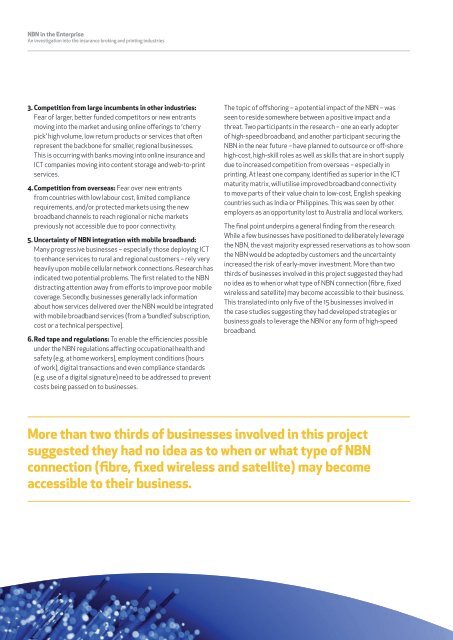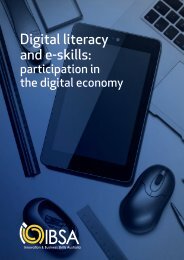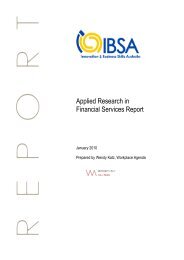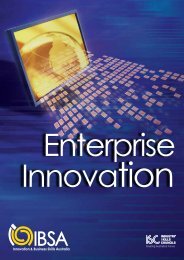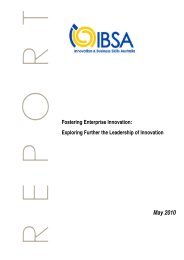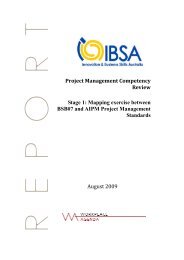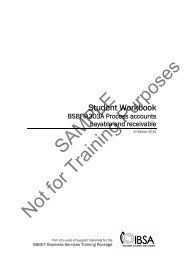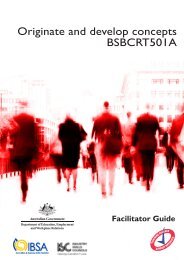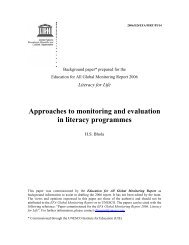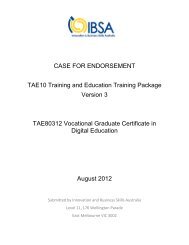<strong>NBN</strong> <strong>in</strong> <strong>the</strong> <strong>Enterprise</strong>An <strong>in</strong>vestigation <strong>in</strong>to <strong>the</strong> <strong>in</strong>surance brok<strong>in</strong>g and pr<strong>in</strong>t<strong>in</strong>g <strong>in</strong>dustries3. Competition from large <strong>in</strong>cumbents <strong>in</strong> o<strong>the</strong>r <strong>in</strong>dustries:Fear of larger, better funded competitors or new entrantsmov<strong>in</strong>g <strong>in</strong>to <strong>the</strong> market and us<strong>in</strong>g onl<strong>in</strong>e offer<strong>in</strong>gs to ‘cherrypick’ high volume, low return products or services that oftenrepresent <strong>the</strong> backbone for smaller, regional bus<strong>in</strong>esses.This is occurr<strong>in</strong>g with banks mov<strong>in</strong>g <strong>in</strong>to onl<strong>in</strong>e <strong>in</strong>surance andICT companies mov<strong>in</strong>g <strong>in</strong>to content storage and web-to-pr<strong>in</strong>tservices.4. Competition from overseas: Fear over new entrantsfrom countries with low labour cost, limited compliancerequirements, and/or protected markets us<strong>in</strong>g <strong>the</strong> newbroadband channels to reach regional or niche marketspreviously not accessible due to poor connectivity.5. Uncerta<strong>in</strong>ty of <strong>NBN</strong> <strong>in</strong>tegration with mobile broadband:Many progressive bus<strong>in</strong>esses – especially those deploy<strong>in</strong>g ICTto enhance services to rural and regional customers – rely veryheavily upon mobile cellular network connections. Research has<strong>in</strong>dicated two potential problems. The first related to <strong>the</strong> <strong>NBN</strong>distract<strong>in</strong>g attention away from efforts to improve poor mobilecoverage. Secondly, bus<strong>in</strong>esses generally lack <strong>in</strong>formationabout how services delivered over <strong>the</strong> <strong>NBN</strong> would be <strong>in</strong>tegratedwith mobile broadband services (from a ‘bundled’ subscription,cost or a technical perspective).6. Red tape and regulations: To enable <strong>the</strong> efficiencies possibleunder <strong>the</strong> <strong>NBN</strong> regulations affect<strong>in</strong>g occupational health andsafety (e.g. at home workers), employment conditions (hoursof work), digital transactions and even compliance standards(e.g. use of a digital signature) need to be addressed to preventcosts be<strong>in</strong>g passed on to bus<strong>in</strong>esses.The topic of offshor<strong>in</strong>g – a potential impact of <strong>the</strong> <strong>NBN</strong> – wasseen to reside somewhere between a positive impact and athreat. Two participants <strong>in</strong> <strong>the</strong> research – one an early adopterof high-speed broadband, and ano<strong>the</strong>r participant secur<strong>in</strong>g <strong>the</strong><strong>NBN</strong> <strong>in</strong> <strong>the</strong> near future – have planned to outsource or off-shorehigh‐cost, high-skill roles as well as skills that are <strong>in</strong> short supplydue to <strong>in</strong>creased competition from overseas – especially <strong>in</strong>pr<strong>in</strong>t<strong>in</strong>g. At least one company, identified as superior <strong>in</strong> <strong>the</strong> ICTmaturity matrix, will utilise improved broadband connectivityto move parts of <strong>the</strong>ir value cha<strong>in</strong> to low-cost, English speak<strong>in</strong>gcountries such as India or Philipp<strong>in</strong>es. This was seen by o<strong>the</strong>remployers as an opportunity lost to <strong>Australia</strong> and local workers.The f<strong>in</strong>al po<strong>in</strong>t underp<strong>in</strong>s a general f<strong>in</strong>d<strong>in</strong>g from <strong>the</strong> research.While a few bus<strong>in</strong>esses have positioned to deliberately leverage<strong>the</strong> <strong>NBN</strong>, <strong>the</strong> vast majority expressed reservations as to how soon<strong>the</strong> <strong>NBN</strong> would be adopted by customers and <strong>the</strong> uncerta<strong>in</strong>ty<strong>in</strong>creased <strong>the</strong> risk of early-mover <strong>in</strong>vestment. More than twothirds of bus<strong>in</strong>esses <strong>in</strong>volved <strong>in</strong> this project suggested <strong>the</strong>y hadno idea as to when or what type of <strong>NBN</strong> connection (fibre, fixedwireless and satellite) may become accessible to <strong>the</strong>ir bus<strong>in</strong>ess.This translated <strong>in</strong>to only five of <strong>the</strong> 15 bus<strong>in</strong>esses <strong>in</strong>volved <strong>in</strong><strong>the</strong> case studies suggest<strong>in</strong>g <strong>the</strong>y had developed strategies orbus<strong>in</strong>ess goals to leverage <strong>the</strong> <strong>NBN</strong> or any form of high-speedbroadband.More than two thirds of bus<strong>in</strong>esses <strong>in</strong>volved <strong>in</strong> this projectsuggested <strong>the</strong>y had no idea as to when or what type of <strong>NBN</strong>connection (fibre, fixed wireless and satellite) may becomeaccessible to <strong>the</strong>ir bus<strong>in</strong>ess.4
1.2 Perceived <strong>NBN</strong> derived futures, <strong>the</strong> drivers and <strong>the</strong> enablersThis section summarises <strong>in</strong>dustry research and consultative feedback that was ga<strong>the</strong>red through an <strong>in</strong>dustry foresight<strong>in</strong>g process.The foundation feedback was derived through three separate <strong>in</strong>dustry foresight<strong>in</strong>g focus groups.1.2.1 Drivers <strong>in</strong> summaryThe follow<strong>in</strong>g table lists <strong>the</strong> major drivers shap<strong>in</strong>g <strong>the</strong> impact of <strong>the</strong> <strong>NBN</strong> on enterprises <strong>in</strong> both <strong>in</strong>dustries.Table 1: Major drivers shap<strong>in</strong>g <strong>the</strong> impact of <strong>the</strong> <strong>NBN</strong> on enterprises <strong>in</strong> <strong>the</strong> pr<strong>in</strong>t<strong>in</strong>g and <strong>in</strong>surance brok<strong>in</strong>g <strong>in</strong>dustriesFutureDrivers1. Compet<strong>in</strong>g andsurviv<strong>in</strong>g <strong>in</strong>dustrystructural changeBoth <strong>in</strong>dustries face changes <strong>in</strong> <strong>the</strong> competition landscape. In <strong>in</strong>surance brok<strong>in</strong>g <strong>the</strong>re is evidence of significantmergers, acquisition and grow<strong>in</strong>g amalgamation of entities <strong>in</strong>to fewer and much larger companies. Fundamentally,six <strong>in</strong>surance companies write <strong>in</strong> excess of $35 billion premiums, or some 85% of all premiums. 1 In pr<strong>in</strong>t<strong>in</strong>g <strong>the</strong>traditional <strong>in</strong>dustry is <strong>in</strong> long-term decl<strong>in</strong>e while digital services grow, ei<strong>the</strong>r as part of an exist<strong>in</strong>g bus<strong>in</strong>ess’offer<strong>in</strong>gs or as a basis for new bus<strong>in</strong>ess ventures.2. Meet<strong>in</strong>g changedconsumerpreferencesThe move to digital products, services and distribution is critically impact<strong>in</strong>g <strong>the</strong> pr<strong>in</strong>t<strong>in</strong>g <strong>in</strong>dustry. It also marks<strong>the</strong> <strong>in</strong>dustry trend to move down <strong>the</strong> value cha<strong>in</strong> from manufactur<strong>in</strong>g closer to <strong>the</strong> customer. For <strong>in</strong>surance brokersit is a current reality. Over 10% of personal <strong>in</strong>surance and over 18% of some products (e.g. car <strong>in</strong>surance) are nowbe<strong>in</strong>g sold via onl<strong>in</strong>e ra<strong>the</strong>r than face-to-face or through call centres. Consumer preferences are shift<strong>in</strong>g and B2Cecommerce and digital distribution cont<strong>in</strong>ues to grow. 23. Search<strong>in</strong>gfor processefficiencies andcost sav<strong>in</strong>gAs economic growth slows and private hous<strong>in</strong>g construction and expenditure tightens it is expected that all f<strong>in</strong>anceand <strong>in</strong>surance companies, <strong>in</strong>clud<strong>in</strong>g <strong>in</strong>surance brokers, will look for greater efficiencies and ways to reduce costs.This may <strong>in</strong>clude reduc<strong>in</strong>g workforce numbers. For pr<strong>in</strong>t<strong>in</strong>g enterprises, <strong>in</strong>creased competition and lower marg<strong>in</strong>snecessitate fur<strong>the</strong>r cost sav<strong>in</strong>gs. For both <strong>in</strong>dustries it will certa<strong>in</strong>ly <strong>in</strong>clude an expanded reliance on automation,digital technologies, onl<strong>in</strong>e transactions (applications and approvals) and services (outsourced, applicationservices, cloud-based services, Software as a Service or Platform as a Service, etc.).4. Invest<strong>in</strong>g <strong>in</strong> newtechnology andskills on slimmarg<strong>in</strong>sMost bus<strong>in</strong>esses surveyed are fac<strong>in</strong>g tighter marg<strong>in</strong>s, <strong>in</strong>creased competition and operational uncerta<strong>in</strong>ty <strong>in</strong>herent<strong>in</strong> a turbulent global economy. In such circumstances <strong>in</strong>vest<strong>in</strong>g <strong>in</strong> new technologies and ICT skills is both risky anddifficult, especially for small bus<strong>in</strong>esses.5. Build<strong>in</strong>g a newchannel to reachcustomers/clientsBroadband, and <strong>the</strong> grow<strong>in</strong>g connectivity of <strong>the</strong> <strong>Australia</strong>n and global consumer, helps bus<strong>in</strong>esses build newelectronic distribution channels. This can apply to everyth<strong>in</strong>g from <strong>in</strong>surance, advice, direct market<strong>in</strong>g, magaz<strong>in</strong>es,advertis<strong>in</strong>g, and o<strong>the</strong>r publish<strong>in</strong>g. As channels diversify so that new ways are developed to reach customers and tooffer new or modified services and products.6. Attract<strong>in</strong>g andreta<strong>in</strong><strong>in</strong>g skilledworkersEmployers <strong>in</strong> both <strong>in</strong>dustries felt <strong>the</strong> cont<strong>in</strong>ued ability to transform will be cont<strong>in</strong>gent on attract<strong>in</strong>g and reta<strong>in</strong><strong>in</strong>gskilled workers, especially <strong>in</strong> ICT roles. As with o<strong>the</strong>r <strong>in</strong>dustries, <strong>the</strong> <strong>Australia</strong>n labour market is be<strong>in</strong>g profoundlyaffected by regions and certa<strong>in</strong> <strong>in</strong>dustries (e.g. m<strong>in</strong><strong>in</strong>g) enjoy<strong>in</strong>g growth that result <strong>in</strong> certa<strong>in</strong> sectors of <strong>the</strong>economy offer<strong>in</strong>g more attractive careers and salaries. For pr<strong>in</strong>t<strong>in</strong>g this is critical. Not only is <strong>the</strong> <strong>in</strong>dustry facedwith an ag<strong>in</strong>g workforce, it is struggl<strong>in</strong>g to attract new entrants or exist<strong>in</strong>g skilled employees from o<strong>the</strong>r <strong>in</strong>dustries.In addition, young people, and <strong>in</strong> particular females, are not see<strong>in</strong>g high technology skills tied to a traditional tradeas an attractive first choice career option. 31KPMG, 2011, page 5.2KPMG, 2011, page 7.3IBSA, 2012, eScan, Pr<strong>in</strong>t<strong>in</strong>g & Graphic Arts Industry, page 23.5


